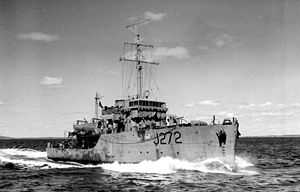HMCS Esquimalt (J272)
 HMCS Esquimalt | |
| Career (Canada) | |
|---|---|
| Namesake: | Township of Esquimalt |
| Builder: | Marine Industries Ltd. |
| Laid down: | 20 December 1940 |
| Launched: | 8 August 1941 |
| Commissioned: | 26 October 1942 |
| Honours and awards: | Atlantic 1943-44,[1] Gulf of St. Lawrence 1942.[2] |
| Fate: | Sunk 16 April 1945 |
| General characteristics | |
| Class & type: | Bangor-class minesweeper |
| Displacement: | 592 tons |
| Length: | 162 ft (49 m) |
| Beam: | 28 ft (8.5 m) |
| Draught: | 8.3 ft (2.5 m) |
| Propulsion: | Twin shaft, 2 9-cyl H&W diesel engines, 2,400 bhp (1,800 kW) |
| Speed: | 16 knots (30 km/h) |
| Complement: | 71 |
| Armament: |
|
HMCS Esquimalt (J272) was a Bangor-class minesweeper that served in the Royal Canadian Navy during World War II.
The Esquimalt served on the Atlantic coast of Canada conducting anti-submarine patrols in the approaches to Halifax Harbour. She was torpedoed and sunk off Chebucto Head, Nova Scotia by U-190 on 16 April 1945, becoming the last RCN warship lost to enemy action in World War II.
Last Patrol

On the evening of 15 April 1945, the Esquimalt sailed from Halifax to go on an anti submarine patrol in the harbour approaches and then to rendezvous with HMCS Sarnia. In the early morning of 16 April she was fired upon by U-190, a German U Boat that had been operating around Halifax since early April. U-190's torpedo struck the Esquimalt's starboard side with the explosion knocking out the onboard power instantly, preventing any distress signal being sent. She started to list heavily to starboard pushing the lifeboat under water, but the crew managed to get four Carley floats clear of the ship. The Esquimalt sank in less than five minutes. Because of the lack of distress calls or signals from the Esquimalt, and the unfortunate timing of the attack itself, any rescue effort was substantially delayed which resulted in many men losing their lives to exposure. The crew was adrift on the carley floats in frigid waters with only light clothing for about six hours. Forty four men died as a result of the attack and the exposure that followed.
See also
- List of ships of the Canadian Navy
- History of the Royal Canadian Navy
References
- ↑ "Battle Honours". Britain's Navy. Retrieved 18 Sep 2013.
- ↑ "Battle Honours 2". Veterans Affairs Canada. Retrieved 18 Sep 2013.
Coordinates: 44°28′N 63°10′W / 44.467°N 63.167°W
| ||||||||||||||